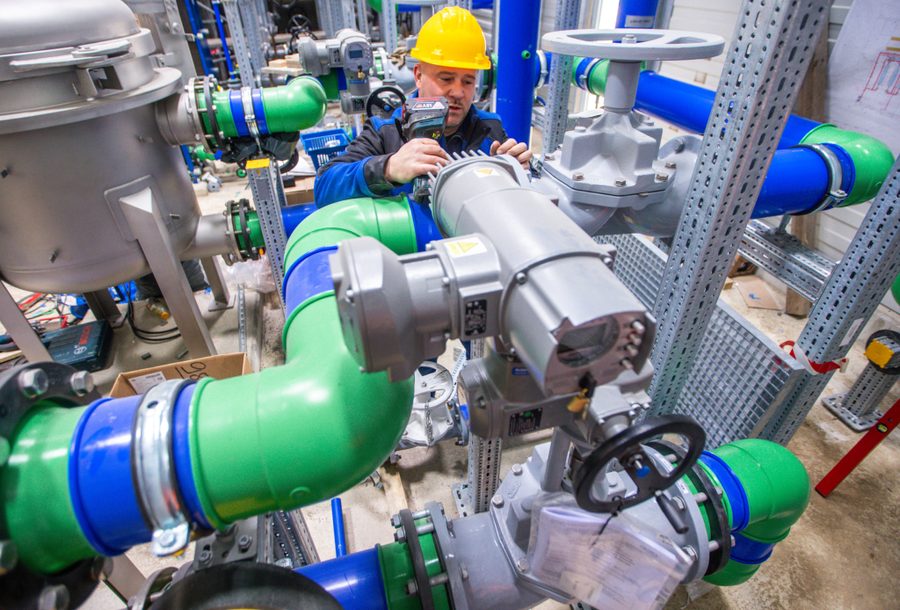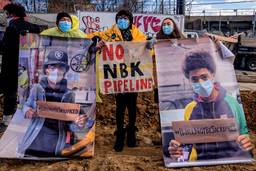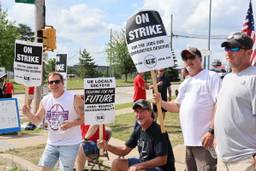This Emerging Green Technology Could Decarbonize Buildings and Provide Good Union Jobs
In New York and states across the country, thermal energy networks are helping unite the climate and labor movements while hastening a just transition away from fossil fuels.
Sara Van Horn

In early 2021, an award-winning design for a “thermal energy network” caught the eye of John Murphy. The design was part of a proposal to decarbonize Empire Plaza in Albany, N.Y., and it featured a series of underground water pipes that balanced the heating and cooling systems of adjacent buildings.
As the International Representative of the New York State Pipe Trades Association, which represents around 25,000 workers across New York State, Murphy had been searching for an renewable energy solution for his members. In his seven years in the position, he has seen how some of the state’s current approaches to the clean energy transition — namely closing power plants without providing alternate jobs — have often left his members unemployed. Without work, they have typically been forced to travel out-of-state to find a job “just to continue their medical coverage, feed their families, and maintain a pension credit,” according to Murphy.
Following a string of power plant closures in recent years, Peter Prince, a steamfitter from upstate New York, has been forced to travel continuously to find union work, resettling in Massachusetts, Pennsylvania, Wisconsin, Minnesota, Illinois and Arizona. Since 2018, Prince has been on-the-road for 12 months out of the year, returning home for Christmas and his daughters’ birthdays. “I’m far away. I don’t see my family,” Prince told In These Times, “I don’t speak to my kids except for a few minutes a day.” According to Prince, this is a hardship shared by the majority of his colleagues.
Murphy’s members, who work on pipes, boilers, and power plants across the state, are crucial to maintaining the gas system which heats most buildings — and which must be phased out to comply with New York State’s landmark Climate Leadership and Community Protection Act of 2019. (New York’s buildings account for nearly one-third of state emissions and over 70% of emissions in New York City alone.)
Because thermal energy networks require the same piping infrastructure that his members are so skilled at constructing and repairing, Murphy was thrilled — and he immediately called Jay Egg, creator of the design, to discuss the proposal.
Jessica Azulay, the executive director of the environmental nonprofit Alliance for a Green Economy, was also excited by Egg’s design. For four years, she has been helping hundreds of households across upstate New York switch to renewable energy by installing backyard heat pumps. Yet Azulay has been worried about the pace of this work. “The house-by-house approach is so slow,” Azulay told In These Times. “We need to find ways to go faster.”
Thermal energy networks, also known as networked geothermal, provide a way to scale up the energy transition. The networks are a series of water pipes that rely initially on heat collected from narrow shafts known as boreholes dug hundreds of feet into the ground, where the ambient temperature remains a relatively stable 55 degrees. Their innovation, however, lies in the way they link together the heating and cooling systems of nearby buildings — forgoing the need to dig a borehole for every building and, crucially, providing the opportunity to transition multiple buildings at once.
“Thermal energy networks give us the chance to not just look house-by-house but block-by-block and neighborhood-by-neighborhood,” explained Allison Considine, senior manager at Building Decarbonization Coalition. According to the U.S. Department of Energy, “Thermal energy storage (TES) is a critical enabler for the large-scale deployment of renewable energy and transition to a decarbonized building stock and energy system by 2050.”
For Zeyneb Magavi, co-executive director of the climate nonprofit Home Energy Efficiency Team, thermal energy networks are a game-changing solution because of how they protect low-income utility consumers. According to Magavi, as millions of homes transition away from fossil fuels in the coming years, there will be a “huge equity risk” for the diminishing pool of utility consumers who will remain on the gas system. Those who rent their home or who don’t have the means to invest in electrification will be stuck paying for increasingly expensive gas. According to a report published by the Building Decarbonization Coalition, this transition, if unchecked, will place a “crushing financial burden on those left on the network, especially low-income New Yorkers.”
According to Murphy, another benefit of the technology is its reliability. Because ground source heat remains stable across both geography and season, it avoids some of the criticisms leveled at other renewable technologies, like solar and wind. Thermal energy networks also reduce strain on the electric grid, using four times less electricity than the current gas system — an especially important statistic given the projected deficiencies in New York State’s electric grid in the coming years.
Most importantly, for labor leaders like Murphy and Brett Thomason, political director at Enterprise Association of Steamfitters Local 638, thermal energy networks offer a growth opportunity for the union workforce. “If the building sector is going to decarbonize in the way that the state and city have mandated,” says Thomason, “this is going to be one of the solutions for a lot of buildings. Not only will it keep our members employed, but it’s an opportunity to build out a workforce based on clean energy.”
When Murphy connected with Azulay and Lisa Dix, the New York Director of the Building Decarbonization Coalition, they talked for hours about their shared interest: a renewable energy solution that could maintain the current piping infrastructure and be replicated at scale. (Scaling up the transition is also a goal of labor unions, which are often able to attach better labor standards to bigger projects.)
The result of this collaboration was the UpgradeNY coalition, which worked to pass the Utility Thermal Energy Network and Jobs Act in the New York State legislature in 2022. The bill, which mandates the seven largest utility companies in the state to pilot thermal energy networks, passed unanimously in the Senate and was quickly signed into law by Gov. Kathy Hochul. The speed of this passage, according to Jeanne Bergman of the climate nonprofit Sane Energy, reflects the strength of the coalition: “Having the utilities, the unions, and the activists on the same project was just huge. There was no opposition.”
To date, there have been at least 14 projects proposed by utility companies like Con Edison and National Grid that implement thermal energy networks in New York State. These experimental pilots, which are set to be approved (or denied) by the state’s Public Service Commission, include proposals for Rockefeller Center and NYCHA buildings in Manhattan. Until the act was signed, utility companies in the state were not permitted to provide any energy source that wasn’t electricity or gas to their customers.
The law also stipulates that every company propose at least one pilot in a “disadvantaged community,” which is defined by New York’s climate law as neighborhoods disproportionately impacted by environmental harms.
According to Thomason, the historical tension between environmental and labor groups “just does not exist” in UpgradeNY. Because thermal energy networks promise an off-ramp for plumbers and pipefitters working in the fossil fuel industry, there’s no conflict between the groups and, instead, a strong incentive to work together. “The more we decarbonize buildings using this technology,” Thomason told In These Times, “the more jobs that creates for our membership.”
The coalition forming around thermal energy networks is not the first time that labor and environmental groups have advocated together in New York State. The campaign to bring offshore wind to the state has relied on over a decade of collaboration between unions and climate organizations. And in 2022, the state passed the Clean Water, Clean Air, Green Jobs Environmental Bond Act, whose success relied on a similar coalition of climate and labor organizers.
Many advocates are eager to see thermal energy networks in the hands of the public sector, with the provision of thermal energy owned by the state or municipal government instead of utility giants like Con Edison and National Grid. The Build Public Renewables Act, passed in New York last year, reflects the demand for public power, with the legislation allowing the state’s public utility to build and own renewables.
The growth of thermal energy networks is not limited to New York — the green technology has made gains in 12 states and Washington, D.C., with the nation’s first pilot project set to be completed in Framingham, Mass this winter. Last year, Colorado passed legislation directing gas utilities to build thermal energy networks, and Illinois, Vermont and Washington have all filed similar bills. On a federal level, the Inflation Reduction Act (IRA) provides a 50% investor tax credit for thermal energy networks, and in October 2023, MIT Technology Review declared that thermal energy networks are “becoming crucial to the US’s energy future.
One current difficulty in the implementation of thermal energy networks is a lack of local drillers. (The Framingham pilot project had to rely on drills imported from Alabama and Michigan). According to Magavi, however, the solutions are simple: lower the price of drills and train more drillers.
Murphy says that thermal energy networks provide “as close to a just transition as you will find in the energy transformation that we’re seeing.” Thomason, like Murphy, has high hopes for the technology within the renewable transition. “For the building sector, this is probably going to be the best solution,” Thomason told In These Times.
Five years ago, Caitlin Heerdt, a welder from Long Island, found herself forced out of New York to find work. When her father passed away from Covid-19, she was unable to find a job in her home state to spend time grieving with her family. For Heerdt, thermal energy networks offer the possibility of “bringing people like myself home.”
“My members are not partial to what runs through pipe,” explains Murphy. “They just want to work. They want to be able to provide for their family because they followed all the rules, they’ve gotten all the training, and they want to be part of the clean energy transition.”
Sara Van Horn is a writer from Brooklyn and a former editorial intern at In These Times. Her writing has appeared in The Nation, Bookforum, and elsewhere.








